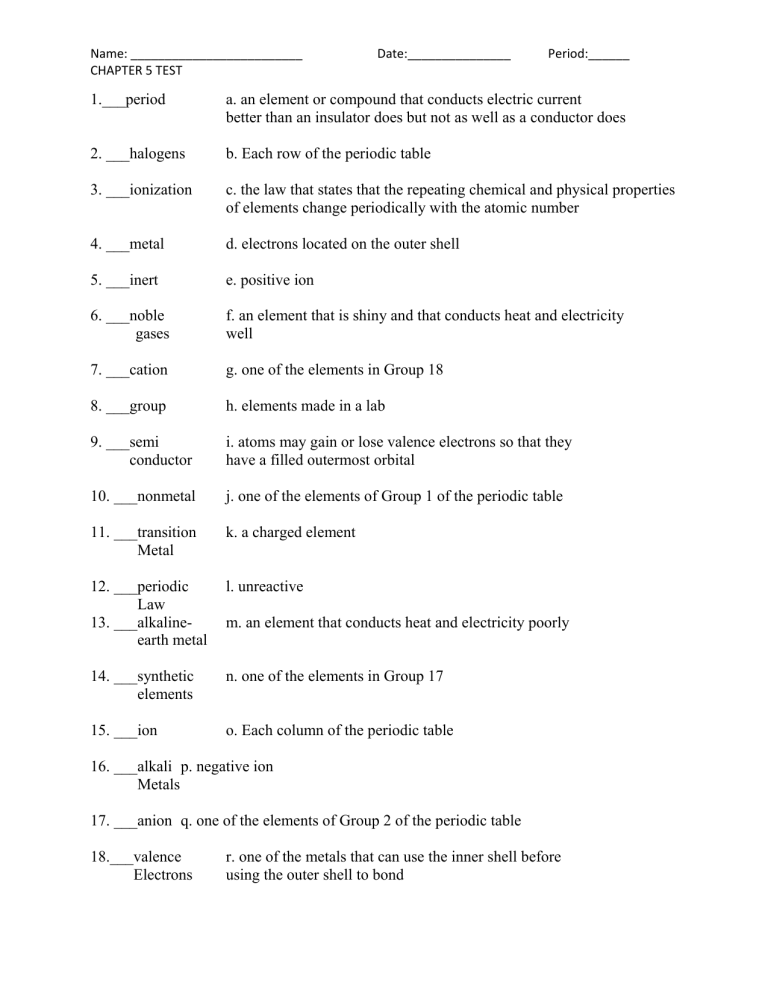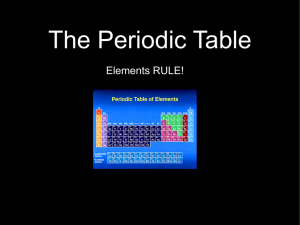Chapter 5 Test
advertisement

Name: _________________________ CHAPTER 5 TEST Date:_______________ Period:______ 1.___period a. an element or compound that conducts electric current better than an insulator does but not as well as a conductor does 2. ___halogens b. Each row of the periodic table 3. ___ionization c. the law that states that the repeating chemical and physical properties of elements change periodically with the atomic number 4. ___metal d. electrons located on the outer shell 5. ___inert e. positive ion 6. ___noble gases f. an element that is shiny and that conducts heat and electricity well 7. ___cation g. one of the elements in Group 18 8. ___group h. elements made in a lab 9. ___semi conductor i. atoms may gain or lose valence electrons so that they have a filled outermost orbital 10. ___nonmetal j. one of the elements of Group 1 of the periodic table 11. ___transition Metal k. a charged element 12. ___periodic Law 13. ___alkalineearth metal l. unreactive 14. ___synthetic elements n. one of the elements in Group 17 15. ___ion o. Each column of the periodic table m. an element that conducts heat and electricity poorly 16. ___alkali p. negative ion Metals 17. ___anion q. one of the elements of Group 2 of the periodic table 18.___valence Electrons r. one of the metals that can use the inner shell before using the outer shell to bond Name: _________________________ CHAPTER 5 TEST Date:_______________ Period:______ Fill IN THE BLANK atomic mass family synthetic atomic number Salts valence Electron metallic elements Noble Gases group properties Dimitri Mendeleev 19. __________ is the father of the periodic table. 20. In Mendeleev’s periodic table, he arranged elements in rows by increasing ___________. 21. The modern periodic table organizes elements by _________________. 22. When the elements are arranged by atomic number, elements have similar __________ appear at regular intervals. 23. Elements become less __________ across each period. 24. Elements in a ___________ have similar properties. 25. The periodic trends in the periodic table are the result of ___________ arrangement. 26. The chemical properties of each group are largely determined by the number of__________ electrons. 27. All ____________ are either metals, nonmetals, or semiconductors. 28. The elements in a _______________ have the same number of valence electrons. 29. Like promethium and technetium, all elements that have an atomic number greater than 92 are _______________. 30. __________________ are relatively inert. 31. Halogens combine easily with metals to form _____________. Name: _________________________ CHAPTER 5 TEST Date:_______________ CONSTRUCTED RESPONSE 32. List the 3 forms of carbon. 33. List the 6 nonmetals that are not a part of Group 17 and Group 18. 34. Why did Mendeleev leave gaps in the periodic table? 35. How are elements classified? List the properties of each classification. Period:______




